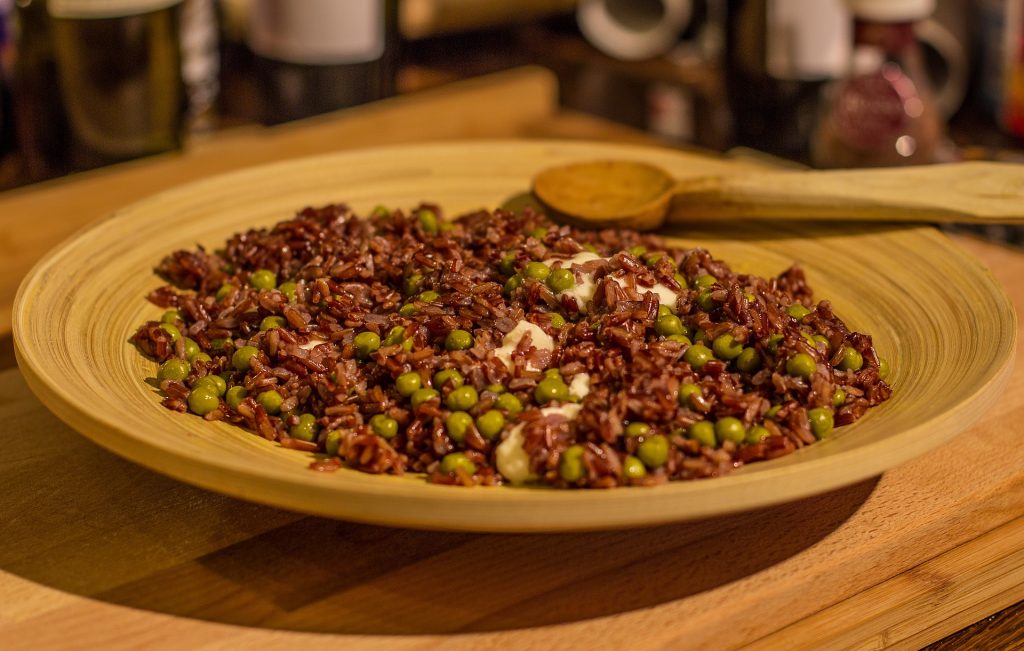**The posts I write might contain affiliate links or be written in collaboration with businesses or brands. Please see my disclosure policy for more information.**
By Bonnie Brost, licensed and registered dietitian at Essentia Health.
Eating the Mediterranean Way | The Mediterranean Diet
There are plenty of diets and eating plans that profess to help you get to better health.
Research consistently emphasizes the same foods: vegetables, fruits, beans, legumes, nuts, seeds and whole grains. You also need to banish highly processed foods that deliver concentrated doses of refined starch, sugar, salt, trans fats and certain saturated fats
One plan that I like to share with my patients is the Mediterranean diet. It’s not a diet that you start and stop. It’s a specific pattern of eating, not specific dishes or cuisine. Its pyramid reflects the traditional food patterns of countries around the Mediterranean whose people had little incidence of heart disease, diabetes or cancer. Eating the Mediterranean way has also been shown to decrease cognitive decline as we age, so our minds may also stay sharper.
The Mediterranean diet hits the sweet spot because it’s delicious, easy to follow and emphasizes foods that help lower insulin levels and the risk of diabetes while also reducing inflammation.
Tips on a The Mediterranean Diet from the Academy of Nutrition and Dietetics:
Build a strong base
Fruits, vegetables and whole grains are the foundation of the Mediterranean diet. They deliver vitamins and minerals our bodies need, carbohydrates for energy and fiber for smooth digestion. Instead of making meat the main event, use plant-based foods as the foundation for hearty meals. Think pasta with vegetables, minestrone soup or stir-fried veggies over brown rice. Fruits are a great option for dessert and snacks.
Get friendly with beans
You won’t find lots of red meat or even much chicken in this diet, but there are plenty of beans and lentils. Beans are a powerhouse of nutrition. They’re loaded with plant protein, fiber and carbohydrates. Naturally low in fat, beans also supply potassium, magnesium and iron. Eat more beans by slipping chickpeas into salads, tossing peas into rice or tucking mashed pinto beans into a quesadilla.
Opt for seafood
Fish plays a starring role in the Mediterranean diet. It is a top source of heart- and brain-friendly omega-3 fatty acids, plus fish is packed with protein. Seafood cooks quickly, making it perfect for quick meals. Grill shrimp and toss into pasta marinara, or stir tuna into whole-wheat couscous.
Lose the fat phobia
Healthful monounsaturated and polyunsaturated fats from olive oil, nuts and seeds are an important part of the Mediterranean diet. In addition to making olive oil your go-to cooking oil, toss pine nuts or slivered almonds into sautéed green beans, spinach or asparagus. Let kids design their own trail mix using their favorite dried fruits, whole-grain cereals, nuts and seeds.
Dip It
We love just about anything we can dip. Dunk veggies into Mediterranean-inspired spreads such as hummus, tzatziki (a creamy cucumber yogurt dip) or baba ghanoush (made from eggplant and sesame).
Check out the website of the Oldways Mediterranean Foods Alliance. You’ll find information, recipes and even a quiz, “How Mediterranean is Your Diet?” You can find a four-week menu plan with recipes, like the two I share below. As I prepared them, I realized they are easy hot dishes for the Minnesota Mediterranean way.

Pasta or Brown Rice with Peas

Pasta or Brown Rice with Peas
4 eggs, beaten
¼ cup grated Parmesan cheese
1½ cup frozen peas and carrots
4 cups cooked whole-wheat linguini or 4 cups cooked brown rice
1 tablespoon extra-virgin olive oil
½ cup onion, thinly sliced
¼ teaspoon salt (optional)
¼ teaspoon pepper (optional)
Cook pasta or brown rice according to package directions. Drain. Combine eggs and parmesan cheese in a small bowl. Beat well and set aside. Place frozen peas and carrots in a strainer and rinse under hot water. Set aside.
Heat olive oil in a large skillet. Add onion and sauté for 1 – 2 minutes. Add peas and carrots and cook 1 minute. Add pasta or rice. Toss gently to mix.
Create a well in center of pan by moving mixture to edges. Add eggs and cheese, cook until they are starting to firm up. Toss everything together and cook for another 2 minutes. Season with salt and pepper if desired.
Nutrition Facts (calculated without salt)
Serving size: 1½ cups; calories, 340; total fat, 11 grams; saturated fat, 3 grams; cholesterol, 220 milligrams; sodium, 175 milligrams; carbohydrates, 48 grams; fiber, 8 grams; protein, 18 grams.
Tuna with White Beans, Celery and Peppers

The Mediterranean Diet
1 tablespoon extra-virgin olive oil
1 small onion sliced
2 stalks celery, cut in large chunks
1 red or yellow pepper, seeded and cut into slices
15-ounce can white cannellini beans or great northern beans, drained and rinsed
4-ounce can albacore tuna, drained
½ cup thinly sliced fresh basil or baby spinach leaves
Heat olive oil in a large skillet over medium heat. Add onion, celery and pepper. Sauté for several minutes. Stir in beans and cook for 2 minutes longer. Add tuna and break it up slightly. Add the basil and cook just until it wilts. Serve hot or at room temperature. It’s great served with brown rice.
Nutrition facts
Serving size: 1 cup; calories, 170; total fat, 4 grams; saturated fat, 1 gram; cholesterol, 8 milligrams; sodium, 225 milligrams; potassium, 450 milligrams; carbohydrates, 22 grams; fiber, 7 grams; protein, 13 grams.

Bonnie Brost
Bonnie Brost is a licensed and registered dietitian at Essentia Health of Brainerd, Minnesota.
